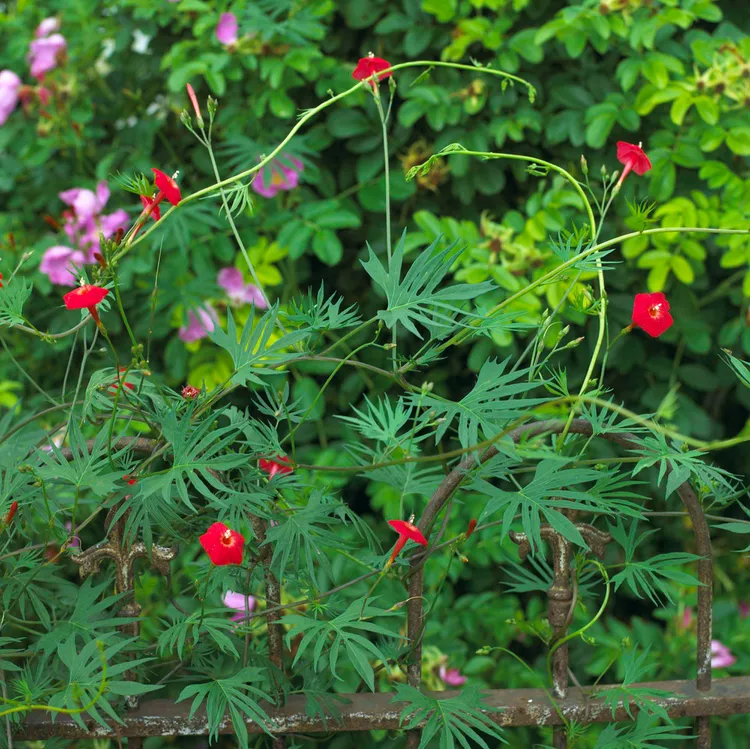How to Plant and Grow Cardinal Climber

Cardinal climber is a noteworthy plant for several reasons, starting with its history. This annual vine is the result of a home gardener, Logan Sloter, in Ohio crossbreeding red morning glory (Ipomoea coccinea) and cypress vine (I. quamoclit), two vines that are native to Central and South America. After years of attempts, Mr. Sloter finally succeeded in 1908. The fast-growing vine with lacy, fernlike foliage and bright, trumpet-shaped flowers was named after him, I. sloteri.
What is remarkable about this plant is that it reproduces plants that are true to the parent (hybrids normally don’t). The flowers begin appearing in midsummer and continue to bloom until the first frost, closing at night. They produce a lot of nectar, so planting cardinal climber is a great way to attract pollinators to your yard.
Like all morning glories, cardinal climber is toxic to humans and pets.
Cardinal Climber Overview
| Genus Name | Ipomoea sloteri |
| Common Name | Cardinal Climber |
| Plant Type | Annual, Vine |
| Light | Sun |
| Height | 10 to 15 feet |
| Width | 1 to 2 feet |
| Flower Color | Red |
| Season Features | Fall Bloom, Summer Bloom |
| Special Features | Attracts Birds, Good for Containers, Low Maintenance |
| Propagation | Seed |
Where to Plant Cardinal Climber
Plant this annual vine in full sun and well-drained soil with a near-neutral pH. The best spot is at the base of an arbor or trellis in a foundation garden or near a patio where you can enjoy the antics of hummingbirds and butterflies. You can also plant it as a fast-growing seasonal groundcover to fill the bare spots left by spring bulbs.
Cardinal climber is a good choice for containers, too, but it needs to be kept off the ground so it doesn't overgrow other plants. This vine will attach to trees and shrubs, so make sure that's the look you have in mind when you plant it next to such specimens.
How and When to Plant Cardinal Climber
Cardinal climbers do not like being transplanted, so it is best to start them from seed. Ideally, you should plant the seeds directly outdoors after all danger of frost has passed and the nighttime temperature remains consistently over 50 degrees F. If your growing season is very short, you can also start the seeds indoors four to six weeks before your average last frost date.
Plant the seeds ¼ to ½ inch deep, 4 to 6 inches apart. Tamp down the soil and keep it evenly moist but not soggy. Once the seedlings have emerged, thin them to 10 to 12 inches apart.
More instructions about starting cardinal climber from seed can be found under How to Propagate Cardinal Climber below.
Cardinal Climber Care Tips
Light
Cardinal climber needs full sun to thrive, at least six to eight hours per day. It can grow in part sun, but there will be fewer blooms. Check how sunlight appears in your garden before deciding where to plant cardinal climber.
Soil and Water
The vine prefers moist, well-drained soil but adapts to a variety of soil conditions, from nutrient-poor sandy soil to rich loam with a near-neutral pH between 6.0 and 7.2. It tolerates dry soil but grows best with regular deep waterings, especially during extended dry spells.
Temperature and Humidity
Cardinal climber is a heat-loving, frost-tender vine. As warm summer days arrive, it starts its growth spurt and blooms from midsummer until the plant is killed by the first fall frost. It is also tolerant of humidity.
Fertilizer
The vine usually does not require fertilizer unless planted in poor soil or grown in a container where the nutrients are washed out of the soil. Apply a complete balanced fertilizer, diluted to half strength, about once a month during the summer. If the soil is too rich, you will get lots of vines but few flowers.
Pruning
Cardinal climber is also low maintenance when it comes to pruning. The flowers do not need to be deadheaded. You can trim the vines to tame their vigorous growth.
Potting and Repotting Cardinal Climber
The required pot size depends on how you want to let the cardinal climber grow. If you plan on trellising it, the container must be deep and large enough to anchor the trellis, so take that as your guide. Pick a container that is made of a heavy material (glazed ceramic or terra-cotta) so it does not topple over under the considerable weight of the vine. If you don’t want to trellis the plant, a container with a 12-inch diameter is sufficient.
Make sure the container has large drainage holes. To give the container more weight and stability, start with a layer of pebbles or small rocks at the bottom before filling it with well-draining potting mix. Keep in mind that container plants need more frequent watering and fertilizer than inground plants.
Cardinal climber being an annual, it won’t require repotting during its single growing season.
Pests and Problems
Cardinal climber has no major pest or disease issues, but rabbits and deer like to munch on it.
How to Propagate Cardinal Climber
Cardinal climber is best propagated from seed. It is an enthusiastic self-seeder, so keep your eyes open for small, round seed pods inside papery brown covers in late fall. Store the pods inside a clean, dry jar in a cool spot until you're ready to plant them.
Prepare the seeds for germination by soaking them in warm water for 24 hours or abrade them with sandpaper; either method will soften the seed coat. Proceed as described above under How and When to Plant Cardinal Climber.